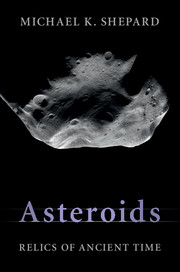Book contents
- Frontmatter
- Dedication
- Contents
- Preface
- Acknowledgements
- Brief list of asteroid and meteorite terms
- 1 It's a small world
- 2 A night at the zoo
- 3 It came from outer space
- 4 A day at the museum
- 5 The gambler's fallacy
- 6 Remembrance of things past
- 7 The ties that bind
- 8 Terra incognita
- 9 To your scattered bodies go
- 10 Scouts, sappers, and miners
- Glossary
- Bibliography
- Index
- References
3 - It came from outer space
Published online by Cambridge University Press: 05 May 2015
- Frontmatter
- Dedication
- Contents
- Preface
- Acknowledgements
- Brief list of asteroid and meteorite terms
- 1 It's a small world
- 2 A night at the zoo
- 3 It came from outer space
- 4 A day at the museum
- 5 The gambler's fallacy
- 6 Remembrance of things past
- 7 The ties that bind
- 8 Terra incognita
- 9 To your scattered bodies go
- 10 Scouts, sappers, and miners
- Glossary
- Bibliography
- Index
- References
Summary
When you have eliminated the impossible, whatever remains, however improbable, must be the truth.
Arthur Conan Doyle, Sign of FourTHE ICE FIELD, ANTARCTICA
Every December and January, about a dozen volunteers spend their holiday season camping on the blue ice of Antarctica. It is summer there then, and with temperatures approaching 0 °C during the day (32 °F), they enjoy the best weather the continent has to offer. Although most of these volunteers are scientists or graduate students, there is the occasional teacher or other non-scientist. But they all have one thing in common – they have come to hunt meteorites.
In December 1969, only six months after humans first stepped on the Moon, Japanese scientists stumbled across an unexpected find – nine meteorites, five of which were completely different from each other, and all found in a very small area of the Antarctic ice. Over the next few years, they increased their bounty with each outing, collecting dozens and then hundreds of new meteorites in each short field season.
The Japanese reported these findings at a 1971 meeting of the Meteoritical Society – the meteorite scientist's analog to the National Geographic or Royal Societies. In the audience was William “Bill” Cassidy, a meteoriticist from the University of Pittsburgh. After their talk, he realized what perhaps nobody else had – there would be thousands, if not hundreds of thousands more. Even better, there were unique conditions that concentrated the meteorites in small areas.
Now Antarctica gets no more meteorites than any other part of the Earth – and perhaps fewer given its polar geography – but meteorites are easier to see here than most other places because they stick out against the white and blue background. And in a place where most of the native rocks are buried hundreds of meters below the surface ice, any rock on the surface is an anomaly unless you're right up on a shedding mountain.
Antarctica is covered by up to three kilometers (two miles) of ice, an enormous continental glacier.
- Type
- Chapter
- Information
- AsteroidsRelics of Ancient Time, pp. 67 - 96Publisher: Cambridge University PressPrint publication year: 2015



